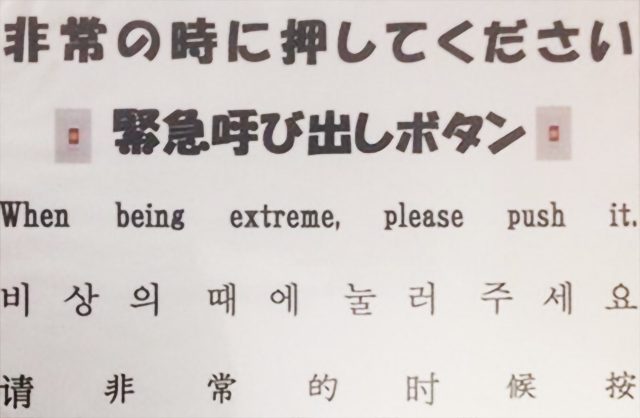
The 2020 Tokyo Olympics and Paralympics were supposed to bring a massive influx of international visitors to the Japanese capital. Although they were eventually forced to be held without overseas spectators due to the coronavirus pandemic, the leadup to the Games involved extensive preparations to accommodate foreign travelers, and a major aspect of this was updated English signage in train stations and other public facilities. Despite such efforts, incorrect or simply perplexing English translations still abound throughout Japan and even in the Tokyo metropolis. Why does Japan seem to struggle so much with English? The term “Engrish,” a reference to the difficulty that many native Japanese speakers experience in distinguishing between the “l” and “r” phonemes, is now well known in the English-speaking world. There are hundreds of blogs dedicated to cataloging amusing English phrases on menus, signs, and T-shirts. But this phenomenon is still poorly understood in the West, and not only in the literal sense.
First, when examining the “Engrish” phenomenon, it is important to keep in mind that not all English text in Japan is created alike. That is to say, the vast majority of English text with which Japanese people interact in their day-to-day lives is not intended to be understandable to native English speakers. Sometimes English is used purely as a decorative element, in a manner comparable to how Chinese characters are incorporated into designs or tattoos in the West with little regard for their actual meanings. We’ve all seen viral social media posts about someone who received a “traditional Asian tattoo” of characters they thought meant “samurai spirit,” only to later discover that the true meaning was “ramen noodles.” Similarly, English as a design element in Japan is not meant to serve any communicative function, but rather to convey an “exotic” or “cosmopolitan” impression, as in the example. Here, fragmented sentences are spliced together with no regard for the rules of English grammar, and actual English phrases are interspersed with Japanese words spelled out in the Latin script. The overall effect is zany and absurd, in the manner that foreign connoisseurs of “Engrish” have come to know and love.
Of course, there is plenty of English text in Japan that is aimed at actual English speakers, and this is where Engrish can become a communicative issue rather than an amusing cultural quirk. Take the restroom signage as an example. On an individual level, each Japanese word seems to be translated into an English one with a roughly equivalent meaning, yet the final result is nonsensical. It is hard to imagine how the original message of “Press the button in the event of an emergency” became so mangled, since “in an emergency” is a set phrase that even automatic translation engines should be able to recognize. We can probably place the blame here squarely on human error, and perhaps more specifically on overreliance on dictionaries. In rule-loving, by-the-book Japan, there is an unfortunate tendency to treat dictionaries as the Bible, with the first entry accepted as the most suitable word choice regardless of context. Hence, “extreme” rather than “emergency.”Another difficulty arises from the vast grammatical differences between the English language and Japanese. In the latter, subjects and objects can frequently be omitted if evident from context. Thus, the Japanese sentence simply instructs the reader to “push” and continues no references to a button. Add to this the unfortunate coincidence that “push it” exists as an idiom in English, as in “push it to the limit,” and a seemingly innocuous instruction is transformed into meme-worthy Engrish.
Finally, there is the third category of English in Japan, which constitutes a sort of gray area. Although it seems, on the surface at least, to be aimed at communicating with foreign speakers, its intended audience is actually native Japanese. The purpose of this kind of “performative English” is to convey a message such as “Look, foreign people frequent this shop!” or “See, we are an internationally minded company!” Japanese people themselves may not be able to distinguish it from the English in the second category. And thus, the English text and signage found in Japan really represent a spectrum, from the absurdist decorative English at one end to the genuine communicative English at the other. While the English as a design element may not follow any grammatical rules, the “performative English” does follow certain rules, or rather conventions, that will make it recognizable as “proper English” to Japanese people. This can lead to phrasings that sound amusing to native English speakers, such as inappropriate use of the phrase “Let’s” before a noun. It is related to the phenomenon of wasei-eigo or “Made in Japan English,” in which English words are repurposed in new ways and with different grammatical functions, such as “my pace” as an adjective to mean “doing things at one’s own pace,” or “challenge” used generally as a verb to mean “trying” or “attempting.”
Is something getting lost in translation? Certainly, but for the reasons explained above, it isn’t entirely fair to call Engrish “wrong” or “broken” English in all cases. It exists in a realm of its own, with its own peculiar logic, and perhaps that is why absurdist Engrish phrasings have won so many fans all over the world.
(日本語訳)
たくさんの外国人観光客が訪れるはずだった2020年東京オリンピック・パラリンピック。新型コロナウイルスの感染拡大で海外からの観戦者はゼロになったが、開催に向けて、駅や公共施設での英語表記の更新など、外国人旅行者を受け入れるためのさまざまな準備が行われていた。それでも、間違った英語表記は日本からなかなか消えない。多くの日本人が「l」と「r」の発音が区別できないことに由来しているEngrishという言葉が英語圏で生まれた。メニューや看板、Tシャツに載っている面白い英語を集めたブログが人気を得ている。なぜ、日本には間違った英語表記がそんなに溢れているのだろうか。
日本における英語表記にはさまざまな目的がある。日本人が日常的に目にしている英語表記のほとんどは、ネイティブに理解されることを意図していない。欧米では漢字が意味に関係なくデザインやタトゥーに取り入れられるのと同じように、日本では英語は単なる装飾要素として使われることがある。こういう「装飾英語」は、コミュニケーションではなく、「MEN’S STYLISH」の例のように、「おしゃれ」「国際的」という印象を与えるためのものである。文法を無視し単語が並べられているだけで、ローマ字表記の日本語も混じっているので、海外の人が好むような、面白い意味不明なEngrishになっている。
もちろん、日本にはコミュニケーション目的の英語表記もあり、この場合はEngrishが大きな問題になる。例えば、トイレの案内表示では、日本語の単語がそれぞれほぼ同じ意味の英単語に訳されているが、全体的には意味不明なものになっている。内容は、機械翻訳でも正しく訳せるはずの定型文なのに、どうしてこんなことが起きてしまったのだろう。ルールが大好きな日本では、辞書に最初に載っている単語を文脈に関係なく採用することが多いのが、emergency ではなくextreme が選ばれた理由なのだろう。また、英語と日本語の文法の違いも関わっている。日本語では、主語や目的語は文脈から想定できる場合は省略してもよいので、英訳は「押してください」という意味だけで、「ボタン」が入っていない。さらに、push itがpush it to the limitのような励みのフレーズを連想させるため、結果としてはトイレにふさわしくない、不思議なEngrishになってしまっている。
最後に、表面的にはコミュニケーションを目的としているように見えるが、実は日本人を対象としている英語表記がある。この「見せかけ英語」の目的は、「この店には外国人のお客さんがよく来るよ!」「うちは国際的な企業だよ!」というアピールである。装飾英語は文法を完全に無視しているのに対し、見せかけ英語は、日本人にとって「正しい英語」として認識されるためにある程度、英文法に沿っているが、それでも間違っていることが多い。Let’s beer、Let’s Englishなど、ネイティブが日本人の英語のものまねをするときによく使われる、名詞の前にLet’sをつけることもその一例である。また、見せかけ英語は「和製英語」が含まれることも多い。
上記のように、日本のEngrishは一見「間違った」「壊れた」英語のように見えるが、実はそれなりの論理がある。だからこそ、世界中で多くのファンを得ているのだろう。
最後まで記事をご覧いただき、ありがとうございます。
株式会社イデア・インスティテュートでは、世界各国語(80カ国語以上)の翻訳、編集を中心に
企画・デザイン、通訳等の業務を行っています。
翻訳のご依頼、お問わせはフォームよりお願いいたします。
お急ぎの場合は03-3446-8660までご連絡ください。



